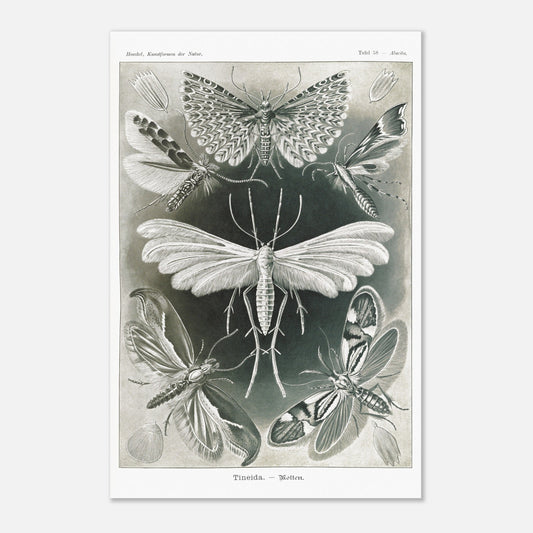Ringworms - Illustrated drawing from life - Ernst Haeckel, Kunstformen der Natur
Ringworms - Illustrated drawing from life - Ernst Haeckel, Kunstformen der Natur
Couldn't load pickup availability
Reproduction engraving of: Moths
Original title Tineida - Motten
Poster of Alucita - Arthropods of the class Insecta (Order Lepidoptera)
Illustration from the book Kunstformen der Natur, which is a collection of artistic lithographs of natural sciences published by the German biologist Ernst Haeckel between 1899 and 1904.
This naturalistic illustration is part of an overall style inspired by Ernst Haeckel, which greatly influenced the emerging Art Nouveau movement at the beginning of the 20th century. This work, illustrating the impressive beauty and great diversity of the biological world, was complemented by a certain amount of scientific information, some excerpts of which are reproduced below.
This information is over 120 years old and some of it may be outdated!
Scientific classification:
Phylum of Arthropods (Articulata) Main class Tracheata Class of Insects (Insecta) Order Lepidoptera Suborder Microlepidoptera Families of Pterophoridae (Pterophoridae, Figs. 1 to 3) and true moths (Tineidae, Figs. 4 to 6)
Scientific notice (extract) accompanying the poster print of Tineida - Teignes :
The moth (Tineida) and moth (Pterophorida) families contain the smallest, most delicate, and insignificant butterflies. However, many species of these so-called small moths (Microlepidoptera) are distinguished by their very delicate shapes, fine patterns, and soft colors. It is enough to observe a few of these small moths with a low-power magnifying glass to be convinced that these modest representatives of the diverse order of butterflies are not inferior, from an aesthetic point of view, to the larger, more imposing, and more colorful forms of this magnificent group. With the extraordinary beauty and diversity of their coloring and patterns, moths surpass not only the majority of other insects, but also invertebrate animals in general. This is due to the scaly coloration and the arrangement of the so-called "moth dust." Each grain of this powder is a foliose scale, egg-shaped or tile-shaped (Figs. 2a, 2b, 5a, 5b). When viewed under high magnification, these "scales" (actually foliose chitinous hairs) show very fine striation. The common motten moths (Tineida, Figs. 4-6) have two pairs of undivided wings, like most other butterflies. The forewings are, as usual, broader and stronger than the hindwings, the rear edge of which is heavily fringed. On the other hand, the Federmotten or feather moths (Pterophorida, Figs. 1-3) are distinguished from all other butterflies by the fact that their wings are deeply cleft or divided into radiating lobes and the lobes are fringed like feathers. In the genus Pterophorus (Figs. 2, 3), the forewings are bipartite, the hindwings tripartite; At rest, the wings are folded together and spread horizontally. In the genus Alucita (Fig. 1), the broader forewings as well as the narrower hindwings are divided into six feathers; at rest, the wings are spread out like a fan. In addition, the Federmotten are distinguished from all other butterflies by the remarkable length of their hind legs; the tibiae (schienen) are more than twice as long as the femurs (oberschenkel).
Species present on the Teignes - Alucita naturalist board :
- Alucita hexadactyla
- Orneodes hexadactyla
- Pterophorus pentadactylus
- Aciptilia pentadactyla
- Pterophorus rhododactylus
- Cnaemidophorus rhododactylus
- Lithocolletis populifolia
- Gracilaria populifolia
- Plutella xylostella
- Cerostoma xylostella
- Harpella geoffroyella
- Geoffroyella grunierella
About this print
About this print
The layout and composition of this reproduction have been the subject of our greatest attention.
- Respect for the format of the original work: in order to faithfully transcribe the artist's intention, the work is not cropped/re-cut except in extreme cases (obvious imperfection, geometry problem, etc.) in which case the cropping will be as light as possible.
- The presence of white margins is sometimes necessary in order to present the work in a balanced manner.
- Each size offered has been specifically composed, therefore, the size of the white margins may vary from one print size to another. Remember to check this detail carefully!
- Print only, frame not included!
Features
Features
- Premium 200gsm matte white paper, durable and strong.
- Natural, smooth uncoated finish, silky to the touch
- FSC certified paper or equivalent certifications depending on regional availability.
- Each print is shipped in sturdy packaging, ensuring safe transport.
- Each print is printed and shipped on demand. No minimum order quantity is required.
Share !









Recently viewed products
We are listening to you
If you are looking for a specific composition, a particular layout, or any other customization need, our team is at your disposal and will do everything possible to meet your requests.
So don't hesitate to...




